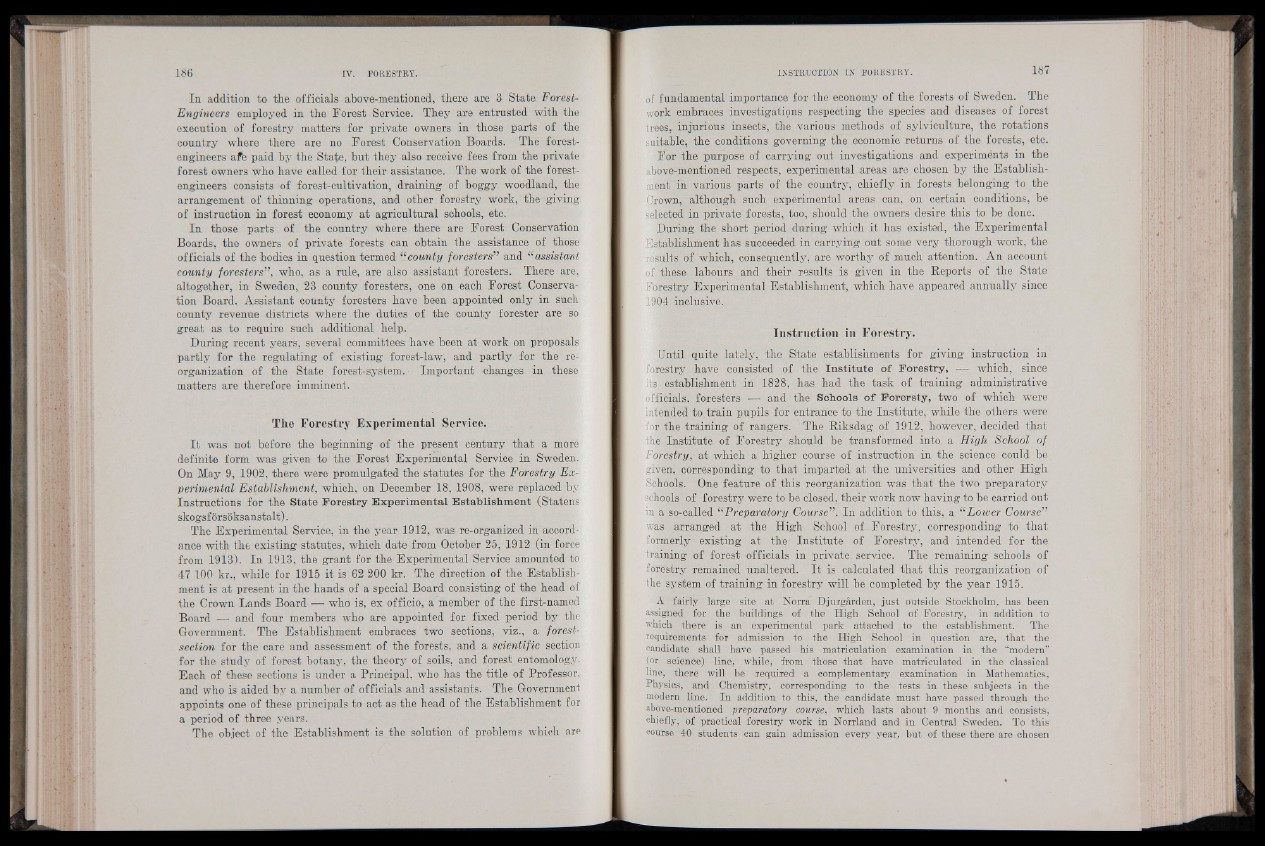
In addition to the officials above-mentioned, there are 3 State Forest-
Engineers employed in the Forest Service. They are entrusted with the
execution of forestry matters for private owners in those parts of the
country where there are no Forest Conservation Boards. The forest-
engineers afe paid by the State, but they also receive fees from the private
forest owners who have called for their assistance. The work of the forest-
engineers consists of forest-cultivation, draining of boggy woodland, the
arrangement of thinning operations, and other forestry work, the giving
of instruction in forest economy at agricultural schools, etc.
In those parts of the country where there are Forest Conservation
Boards, the owners of private forests can obtain the assistance of those
officials of the bodies in question termed “ county foresters” and “ assistant
county foresters”, who, as a rule, are also assistant foresters. There are,
altogether, in Sweden, 23 county foresters, one on each Forest Conservation
Board. Assistant county foresters have been appointed only in such
county revenue districts where the duties of the county forester are so
great as to require such additional help.
During recent years, several committees have been at work on proposals
partly for the regulating of existing forest-law, and partly for the reorganization
of the State forest-system. Important changes in these
matters are therefore imminent.
The Forestry Experimental Service.
It was not before the beginning of the present century that a more
definite form was given to the Forest Experimental Service in Sweden.
On May 9, 1902, there were promulgated the statutes for the Forestry Expérimental
Establishment, which, on December 18, 1908, were replaced by
Instructions for the State Forestry Experimental Establishment (Statens
skogsf ôrsôksanstalt).
The Experimental Service, in the year 1912, was re-organiaed in accordance
with the existing statutes, which date from October 25, 1912 (in force
from 1913). In 1913, the grant for the Experimental Service amounted to
47 100 kr., while for 1915 it is 62 200 kr. The direction of the Establishment
is at present in the hands of a special Board consisting of the head of
the Crown Lands Board — who is, ex officio, a member of the first-named
Board — and four members who are appointed for fixed period by the
Government. The Establishment embraces two sections, viz., a forest-
section for the care and assessment of the forests, and a scientific section
for the study of forest botany, the theory of soils, and forest entomology.
Each of these sections is under a Principal, who has the title of Professor,
and who is aided by a number of officials and assistants. The Government
appoints one of these principals to act as the head of the Establishment for
a period of three years.
The object of the Establishment is the solution of problems which are
of fundamental importance for the economy of the forests of Sweden. The
work embraces investigations respecting the species and diseases of forest
trees, injurious insects, the various methods of sylviculture, the rotations
suitable, the conditions governing the economic returns of the forests, etc.
For the purpose of carrying out investigations and experiménts in the
above-mentioned respects, experimental areas are chosen by the Establishment
in various parts of the country, chiefly in forests belonging to the
Crown, although such experimental areas can, on certain conditions, be
selected in private forests, too, should the owners desire this to be done.
During the short period during which it has existed, the Experimental
Establishment has succeeded in carrying out some very thorough work, the
results of which, consequently, are worthy of much attention. An account
of these labours and their results is given in the Reports of the State
Forestry Experimental Establishment, which have appeared annually since
1904 inclusive.
Instruction in Forestry.
Until quite lately, the State establishments for giving instruction in
forestry have consisted of the Institute o f F o r e s t r y 0 which, since
its establishment in 1828, has had the task of training administrative
officials, foresters '0 $ and the Schools o f Forersty, two of which were
intended to.train pupils for entrance to the Institute, while the others were
for the training of rangers. The Riksdag of 1912, however, decided that
the Institute of Forestry should be transformed into a High School of
Forestry, at which a higher course of instruction in the science could be
given, corresponding to that imparted at the universities and other High
Schools. One feature of this reorganization was that the two preparatory
schools of forestry were to be closed, their work now having to be carried out
in a so-called “Preparatory Course”. In addition to this, a “Lower Course”
was arranged at the High School of. Forestry, corresponding to that
formerly existing at the Institute of Forestry, and intended for the
training of forest officials in private service. The remaining schools of
forestry remained unaltered. It is calculated that this reorganization of
the system of training in forestry will be completed by the year 1915.
A fairly large site at Norra Djurgarden, just outside Stockholm, has been
assigned for the buildings of the High School of Forestry, in addition to
which there is an experimental park attached to the establishment. The
requirements for admission to the High School in question are, that the
candidate shall have passed his matriculation examination in the “modern”
(or science) line, while, from those that have matriculated in the classical
line, there will be required a complementary examination in Mathematics,
Physics, and Chemistry, corresponding to the tests in these subjects in the
modern line. In addition to this, the candidate must have passed through the
above-mentioned preparatory course, which lasts about 9 months and consists,
chiefly, of practical forestry work in Norrland and in Central Sweden. To this
course 40 students can gain admission every year, but of these there are chosen